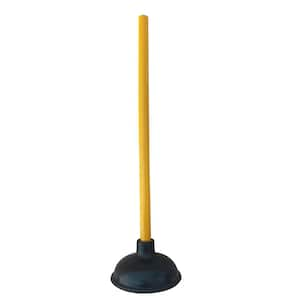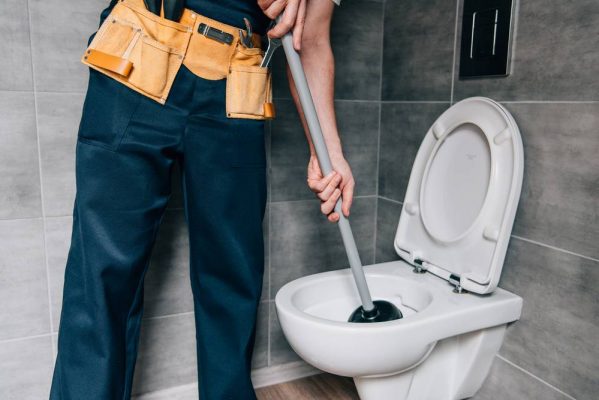Applying Plunger and Drain Cleaner: Efficient Techniques
Applying Plunger and Drain Cleaner: Efficient Techniques
Blog Article
We have uncovered this article involving Tips on How to Effectively Use a Plunger directly below on the web and think it made perfect sense to talk about it with you on this page.

Intro
Appropriate upkeep of family drains pipes is necessary for stopping blockages and making certain smooth water circulation. Among the secret tools in every homeowner's toolkit is the bettor, along with different drain cleansers created to deal with stubborn obstructions successfully. This write-up checks out how to make use of plungers and drainpipe cleansers successfully to keep your drains pipes flowing openly.
Section 1: Comprehending Plungers
Kinds of Plungers
There are numerous kinds of plungers readily available, each developed for various types of drains and obstructs. One of the most common types consist of mug plungers, flange plungers, and accordion bettors.
Just How Plungers Work
Plungers work with the concept of developing pressure and suction to dislodge blockages. When properly applied over a drain, they create a vacuum that can take out debris or break up clogs.
Choosing the Right Plunger
Selecting the best plunger depends on the type of drainpipe and the nature of the blockage. Cup plungers are ideal for sinks and bathtubs, while flange bettors are better matched for bathrooms due to their layout.
Typical Mistakes with Bettors
Staying clear of these errors guarantees reliable plunging: incorrect seal around the drainpipe, inadequate pressure, and not clearing bordering debris.
Section 2: Making Use Of Plungers Efficiently
Prep work
Before plunging, make certain the plunger covers the drain totally and creates a tight seal. Clear any kind of visible debris around the drainpipe opening.
Strategy
Start with mild plunging activities to construct suction. Increase stress gradually, utilizing a constant rhythm. Repeat as required up until the drainpipe gets rid of.
Troubleshooting Tips
If diving does not function, attempt changing the seal, applying oil jelly for a far better seal, or using a different type of bettor.
Section 3: Recognizing Drainpipe Cleansers
Kinds Of Drain Cleansers
Drain cleaners can be chemical or enzymatic. Chemical cleaners utilize strong chemicals to liquify blockages, while chemical cleansers make use of all-natural enzymes to break down raw material.
Exactly How Drain Cleansers Work
Chemical cleaners react with clogs to dissolve them, while chemical cleansers break down natural materials like hair and grease without damaging pipelines.
Security Considerations
Always put on handwear covers and eye security when using chemical drainpipe cleansers. Guarantee adequate air flow and comply with producer instructions meticulously.
Eco-Friendly Alternatives
Take into consideration utilizing vinegar and baking soft drink or enzyme-based cleaners for green choices that are more secure for pipes and the setting.
Section 4: Utilizing Drain Cleansers Effectively
Application Methods
Put chemical cleaners directly into the drainpipe opening. Permit them to work for the suggested time prior to flushing with hot water. Chemical cleansers should sit overnight.
Precautions
Prevent mixing different sorts of cleansers, as this can produce toxic fumes. Never ever use chemical cleaners combined with a bettor, as splashing can take place.
Taking Care Of Stubborn Blockages
For relentless blockages, consider utilizing a plumbing serpent or calling a professional plumbing to stop damages to pipes.
Conclusion
Finally, comprehending just how to utilize bettors and drain cleansers efficiently is essential for preserving healthy and balanced plumbing systems. By picking the right devices and methods, house owners can deal with small clogs and stop major pipes issues down the line.
How to Use a Plunger to Unclog a Drain
The humble plunger is a simple yet effective tool for breaking clogs in sinks, tubs and toilets. This handy tool is easy to use. You can make the most of its power if you understand how it works. Ready to dive in? Here’s what you need to know.
Safety First!
Never use a plunger with drain chemicals. Water will splash as you work, and the chemicals can spatter, burning skin and eyes. It’s a good idea to use rubber gloves and wear safety goggles when you work on a clog.
Choose the Right Tool for the Job
Plungers come in two different styles. Sinks, bathtubs and showers require a cup plunger. Like its name suggests, the rubber end is shaped like a cup. Use a flange plunger on toilets. These plungers have a rubber funnel extending from the cup. A plunger needs to be big enough to cover the drain.
Ready, Set, Plunge!
Coat the rim: Coat the plunger rim with petroleum jelly. This helps make a better seal.
Block outlets: Hold a wet rag over nearby outlets such as the overflow vent or the drain in a second sink.
Release air: Insert the plunger at an angle into the water. Water will displace air in the cup. A water-filled cup is more forceful than one filled with air.
Keep the plunger upright: Hold the plunger perpendicular to the drain. Use fast, forceful strokes, but make the first stroke gentle. The first stroke can create a splash if the cup still contains air. Thrust the plunger 15 to 20 times.
Snap off the plunger: The final stroke should be a strong upward motion that ends when the plunger snaps off the drain.
Repeat the process: you may need to repeat this sequence several times. When the water drains away, your work is done. High-five! https://plumbernw.com/blog/how-to-use-a-plunger-to-unclog-a-drain/

Application Methods
Put chemical cleaners directly into the drainpipe opening. Permit them to work for the suggested time prior to flushing with hot water. Chemical cleansers should sit overnight.
Precautions
Prevent mixing different sorts of cleansers, as this can produce toxic fumes. Never ever use chemical cleaners combined with a bettor, as splashing can take place.
Taking Care Of Stubborn Blockages
For relentless blockages, consider utilizing a plumbing serpent or calling a professional plumbing to stop damages to pipes.
Conclusion
Finally, comprehending just how to utilize bettors and drain cleansers efficiently is essential for preserving healthy and balanced plumbing systems. By picking the right devices and methods, house owners can deal with small clogs and stop major pipes issues down the line.
How to Use a Plunger to Unclog a Drain
The humble plunger is a simple yet effective tool for breaking clogs in sinks, tubs and toilets. This handy tool is easy to use. You can make the most of its power if you understand how it works. Ready to dive in? Here’s what you need to know.
Safety First!
Never use a plunger with drain chemicals. Water will splash as you work, and the chemicals can spatter, burning skin and eyes. It’s a good idea to use rubber gloves and wear safety goggles when you work on a clog.
Choose the Right Tool for the Job
Plungers come in two different styles. Sinks, bathtubs and showers require a cup plunger. Like its name suggests, the rubber end is shaped like a cup. Use a flange plunger on toilets. These plungers have a rubber funnel extending from the cup. A plunger needs to be big enough to cover the drain.
Ready, Set, Plunge!
Coat the rim: Coat the plunger rim with petroleum jelly. This helps make a better seal. Block outlets: Hold a wet rag over nearby outlets such as the overflow vent or the drain in a second sink. Release air: Insert the plunger at an angle into the water. Water will displace air in the cup. A water-filled cup is more forceful than one filled with air. Keep the plunger upright: Hold the plunger perpendicular to the drain. Use fast, forceful strokes, but make the first stroke gentle. The first stroke can create a splash if the cup still contains air. Thrust the plunger 15 to 20 times. Snap off the plunger: The final stroke should be a strong upward motion that ends when the plunger snaps off the drain. Repeat the process: you may need to repeat this sequence several times. When the water drains away, your work is done. High-five! https://plumbernw.com/blog/how-to-use-a-plunger-to-unclog-a-drain/

We had been introduced to that article on from someone on another web page. Be sure to pause to promote this article if you enjoyed it. Thank you for your time spent reading it.
Website Report this page